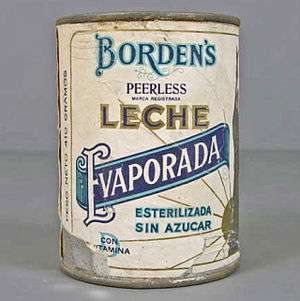Evaporated milk

Evaporated milk, known in some countries as unsweetened condensed milk,[1] is a shelf-stable canned milk product with about 60% of the water removed from fresh milk. It differs from sweetened condensed milk, which contains added sugar. Sweetened condensed milk requires less processing since the added sugar inhibits[2] bacterial growth.
The product takes up half the space of its nutritional equivalent in fresh milk. When the liquid product is mixed with a proportionate amount of water, evaporated milk becomes the rough equivalent of fresh milk. This makes evaporated milk attractive for purposes as it can have a shelf life of months or even years, depending upon the fat and sugar content. This made evaporated milk very popular before refrigeration as a safe and reliable substitute for perishable fresh milk, which could be shipped easily to locations lacking the means of safe milk production or storage.
The process involves the evaporation of 60% of the water from the milk, followed by homogenization, canning, and heat-sterilization.[3]
Evaporated milk infant formulas
_(18406931476).jpg)
In the 1920s and 1930s, evaporated milk began to be widely commercially available at low prices. The Christian Diehl Brewery, for instance, entered the business in 1922, producing Jerzee brand evaporated milk as a response to the Volstead Act.[4] Several clinical studies from that time period suggested that babies fed evaporated milk formula thrive as well as breastfed babies.[5] Modern guidelines from the World Health Organization consider breastfeeding, in most cases, to be healthier for the infant because of the colostrum in early milk production as well as the specific nutritional content of human breast milk.[6]
Definition

Evaporated milk is fresh, homogenized milk from which 60 percent of the water has been removed. After the water has been removed, the product is chilled, stabilized, packaged and sterilized. It is commercially sterilized at 240-245 °F (115-118 °C) for 15 minutes.[7] A slightly caramelized flavor results from the high heat process, and it is slightly darker in color than fresh milk. The evaporation process concentrates the nutrients and the food energy (kcal); unreconstituted evaporated milk contains more nutrients and calories than fresh milk.
Reconstitution and substitution
Evaporated milk is sometimes used in its reduced form; however, to reconstitute evaporated milk to be equivalent to normal milk, mix 1 part by volume of evaporated milk with 1 1/4 parts of water.[1] Where evaporated milk is required but not available, it can be replaced by simmering 2 1/4 parts of fresh milk down to 1 part. A comparable result is obtained by simmering down 2 parts of almond milk.[8]
In the United States
According to the United States Code of Federal Regulations, Title 21, Chapter 1, Part 131, Sub part B, Section 130 "Evaporated milk", (April 2006)
(a) Description. Evaporated milk is the liquid food obtained by
partial removal of water only from milk. It contains not less than 6.5 percent by weight of milk fat, not less than 16.5 percent by weight of milk solids not fat, and not less than 23 percent by weight of total milk solids. Evaporated milk contains added vitamin D as prescribed by paragraph (b) of this section. It is homogenized. It is sealed in a container and so processed by heat, either before or after sealing, as to prevent spoilage. ...
Sections (b) - (f) of the above code regulate vitamin addition, optional ingredients, methods of analysis, nomenclature, and label declaration.[9]
In Malaysia and Singapore
It is added in brewed tea and coffee to make Teh C and Kopi C respectively. The C used in the name were due to a common association to the brand "Carnation Evaporated Milk".
In the Netherlands and Germany
It is widely used as a whitener (Creamer) for coffee.
In Latin America
It is widely used for desserts, added to coffee, tea to create a rich and delicious " Leche con café" or " Te con leche", which is made with half water, half evaporated milk and either coffee or tea and sugar to taste.
Shelf life
The shelf life of canned evaporated milk will vary according to both its added content and its proportion of fat. For the regular unsweetened product a life of fifteen months can be expected before any noticeable destabilization occurs.[10]
Notable producers
Evaporated milk is sold by several manufacturers:
- Carnation Evaporated Milk (the brand is now owned by Nestlé and licensed to Smuckers in Canada)
- PET Evaporated Milk (now owned by Smuckers)
- Magnolia evaporated milk - (now produced by Eagle Family Foods owned by Smuckers )
- Viking Melk (Norway) - invented by Olav Johan Sopp in 1891, a Nestlé brand since 1897
- F&N Evaporated Milk
- Rainbow Milk, a brand of Royal Friesland Foods
- Nordmilch AG (Now DMK Deutsches Milchkontor) - Germany
- Jerzee Evaporated Milk (purchased in 2006 from Diehl Food Products)
- O-At-Ka Evaporated Milk
- Ferdi Evaporated Milk (Malaysia)
- Vitalait Evaporated Milk (Senegal)
- Luna Evaporated Milk
See also
References
- 1 2 "CARNATION FAQs". Nestlé, Carnation FAQs. Archived from the original on 9 February 2013. Retrieved 20 January 2016.
- ↑ "How does sugar act as a preservative?". BBC Worldwide.
- ↑ McGee, Harold (2004). On food and cooking: the science and lore of the kitchen. Simon and Schuster. p. 24. ISBN 978-0-684-80001-1.
- ↑ Diehl records at Bowling Green State University
- ↑ Marriott, William McKim; Schoenthal, L. (1929). "An experimental study of the use of unsweetened evaporated milk for the preparation of infant feeding formulas". Archives of Pediatrics. 46: 135–148.
- ↑ Breastfeeding, World Health Organization.
- ↑ "Evaporated milk". Retrieved 3 February 2015.
- ↑ "Is there a substitute for evaporated milk". Retrieved 7 December 2015.
- ↑ (21CFR131.130):
- ↑ "survival-center.com".
External links
| Wikimedia Commons has media related to Condensed milk. |
- Cooking with Canned Milk, including recipes and tips
- PET History - history of evaporated milk and the PET company.
- Today in Science History - John B. Meyenberg's patent describing his evaporation process of preserving milk